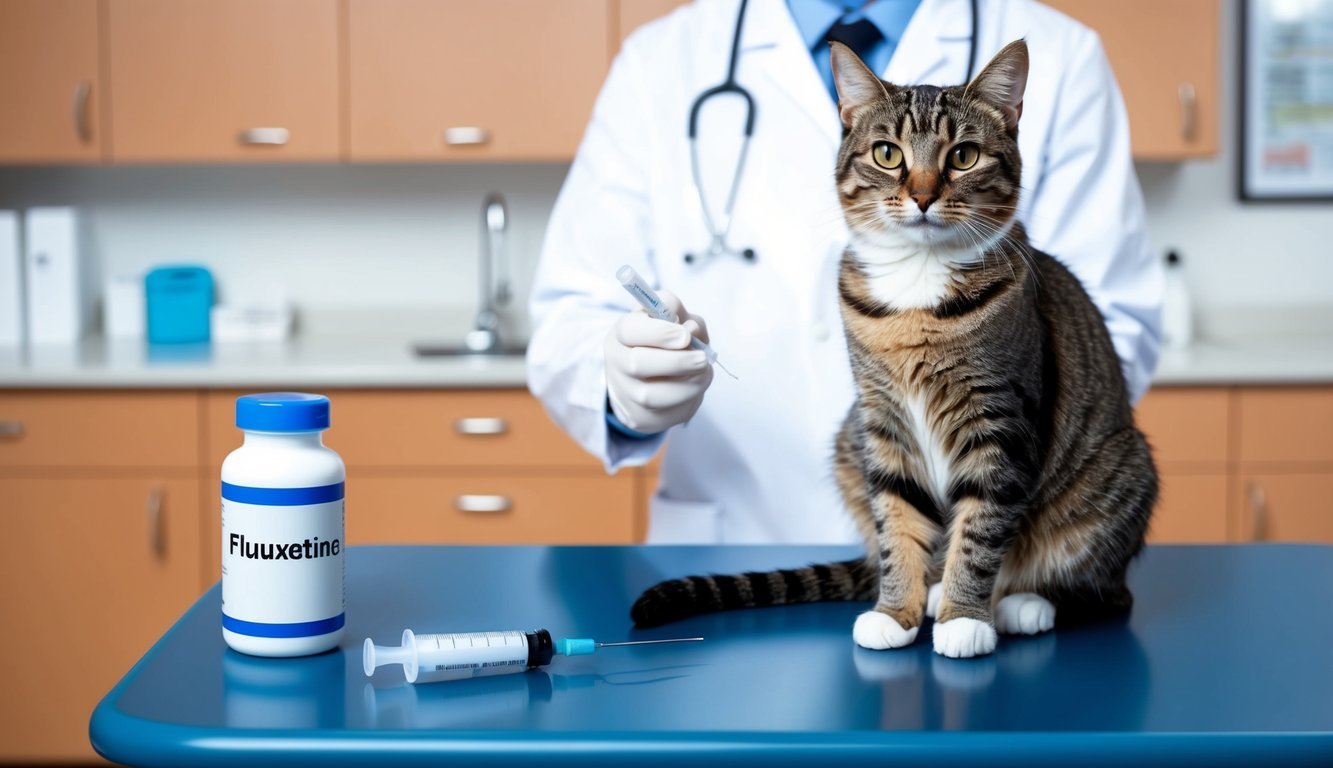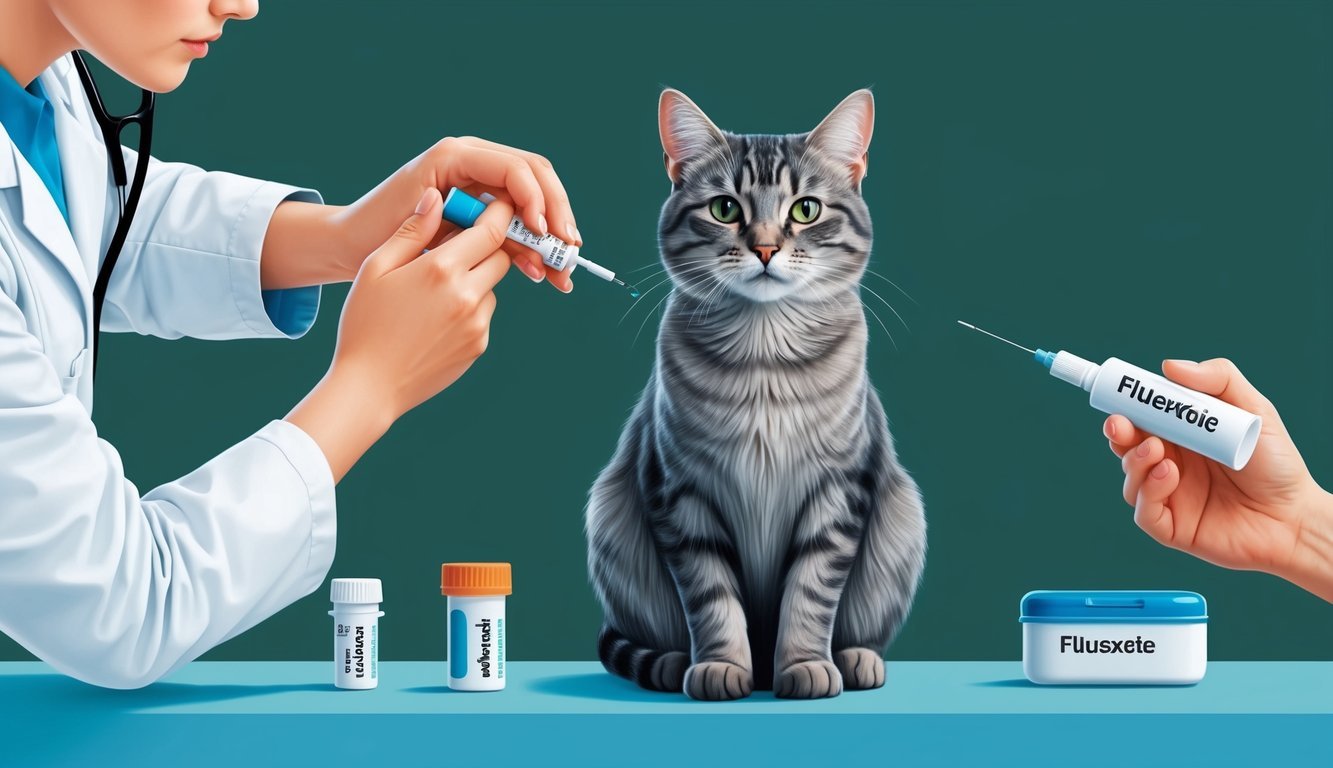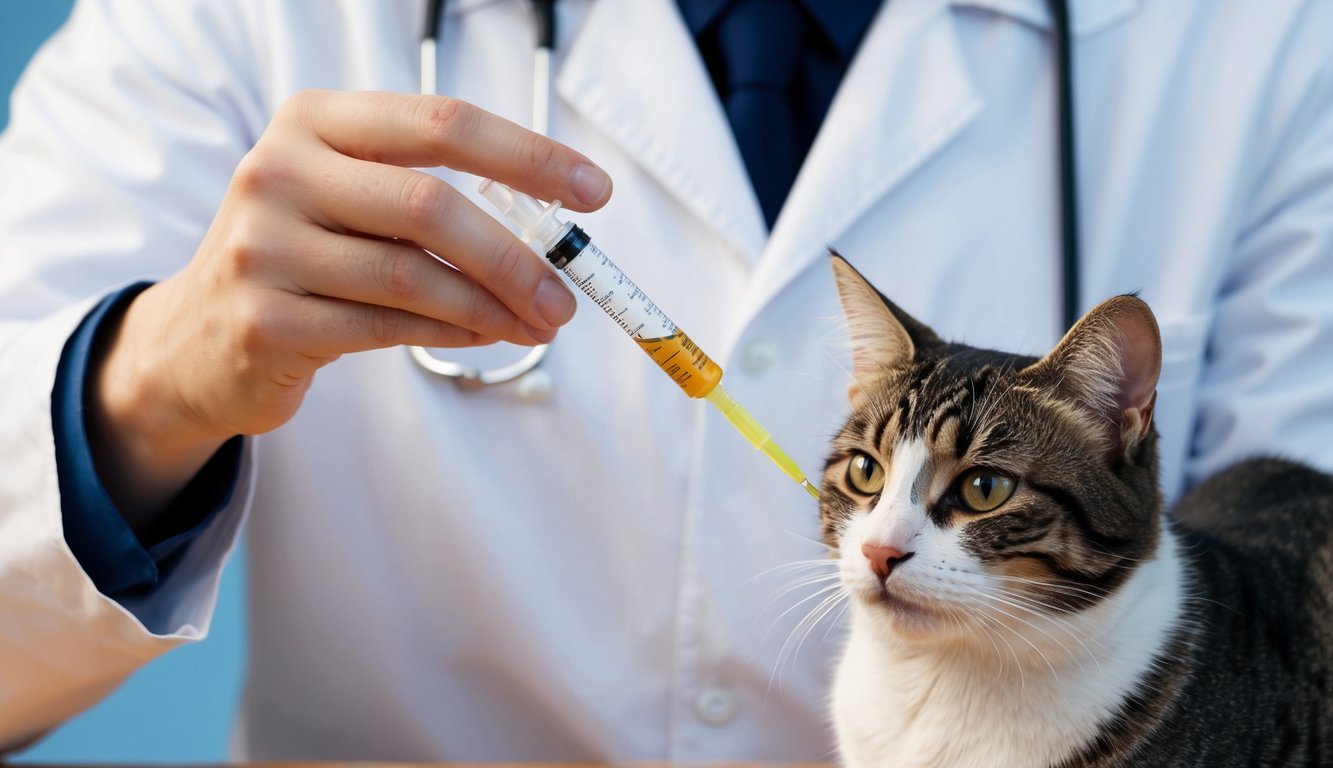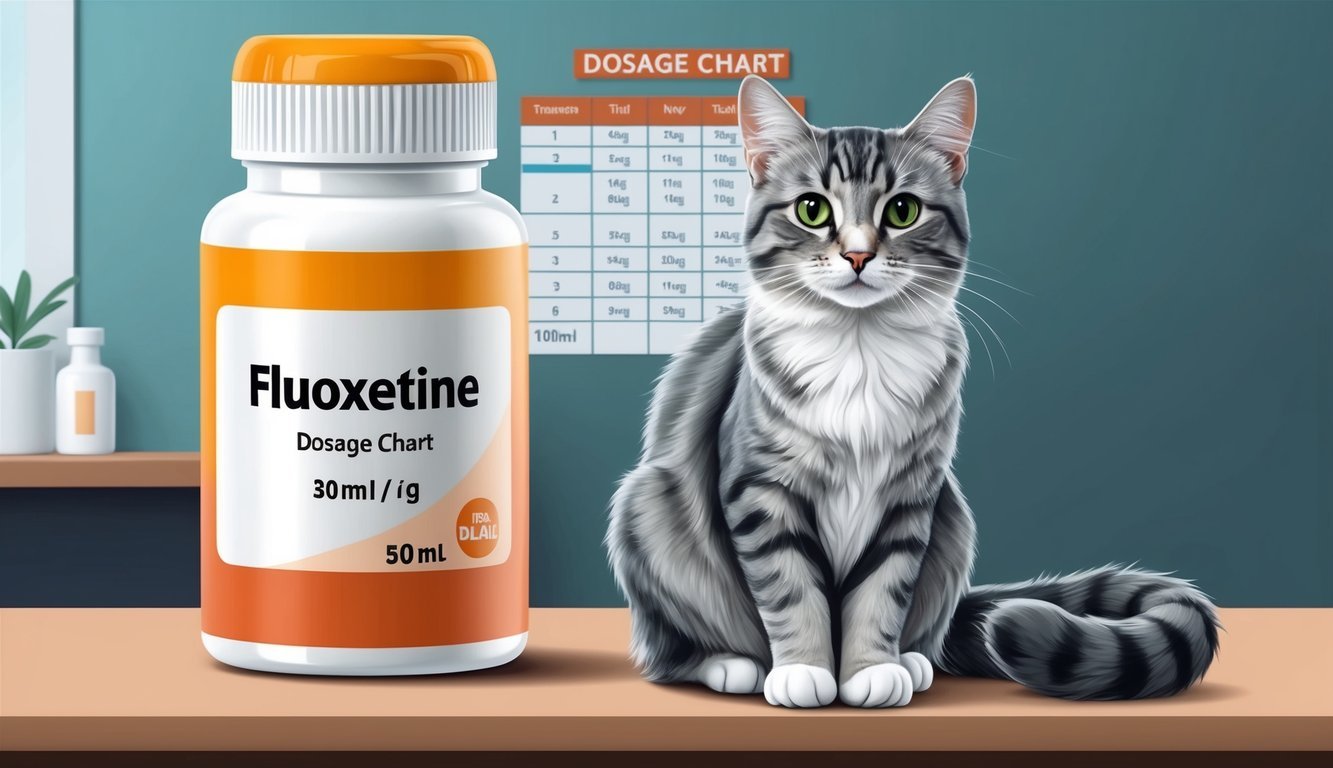Fluoxetine, commonly known for its use in humans, has garnered attention for its effectiveness in treating behavioral issues in cats. Understanding the proper dosage of fluoxetine is crucial for ensuring your feline friend receives the right amount to help manage anxiety, depression, and other behavioral disorders.
If you’ve noticed changes in your cat’s behavior, such as inappropriate urination or aggression, this medication could be a helpful tool in their treatment plan.
You might be wondering how to administer fluoxetine safely and effectively.
The recommended dosage varies based on your cat’s specific needs, so consulting with your veterinarian is essential.
This ensures that you’re giving your pet the best chance for improvement while monitoring for any potential side effects.
Key Takeaways
- Fluoxetine can help manage behavioral disorders in cats.
- Dosage should be tailored to individual needs under veterinary guidance.
- Regular monitoring is important to ensure your cat’s safety and well-being.
Understanding Fluoxetine and Its Role

Fluoxetine is a widely used medication that can help address various behavioral issues in cats.
This section covers what fluoxetine is, how it works in the body, and how it compares to other SSRIs.
What is Fluoxetine?
Fluoxetine, commonly known by its brand name Prozac, is a selective serotonin reuptake inhibitor (SSRI).
It is primarily prescribed to treat anxiety, aggression, and other behavioral problems in cats.
By targeting serotonin, a key neurotransmitter responsible for mood regulation, fluoxetine helps improve your cat’s overall behavior.
While originally developed as an antidepressant for humans, its effectiveness in treating feline behavioral issues has made it a popular choice among veterinarians.
Mechanism of Action of Fluoxetine
Fluoxetine works by increasing serotonin levels in the brain.
When you give your cat fluoxetine, it inhibits the reabsorption of serotonin, allowing more of this neurotransmitter to remain available in the synapses.
This increase in serotonin levels can lead to improved mood and behavioral changes.
Specifically, you might notice signs of reduced anxiety, decreased aggression, or improved overall well-being in your feline friend.
Understanding how fluoxetine functions helps you appreciate its role in managing your cat’s specific behavioral conditions.
Fluoxetine Vs. Other SSRIs
While fluoxetine is well-regarded, it’s not the only SSRI available for cats.
Other options include sertraline and paroxetine.
Each medication has its unique properties and may work differently depending on your cat’s situation.
Fluoxetine is often chosen for its relatively favorable side effect profile and established efficacy in treating feline anxiety and aggression.
Dosage may vary compared to other SSRIs, so it’s crucial to follow your veterinarian’s recommendations strictly.
When considering medication for your cat, discussing the options and their potential impacts can ensure that you find the most suitable treatment plan tailored to your pet’s needs.
Benefits of Fluoxetine for Cats

Fluoxetine offers several advantages for addressing behavioral issues in cats.
It can help reduce anxiety, treat compulsive behaviors, and enhance your cat’s overall quality of life.
Understanding these benefits will allow you to make informed decisions about your pet’s health.
Anxiety and Stress Reduction
Many cats experience anxiety due to various factors, including changes in environment or routine.
Fluoxetine, a selective serotonin reuptake inhibitor (SSRI), works by increasing serotonin levels in the brain, which can help alleviate feelings of anxiety.
This medication is particularly effective for conditions such as separation anxiety, where your cat might feel distressed when left alone.
By stabilizing your cat’s mood, fluoxetine can lead to a calmer demeanor and reduced stress-related behaviors, such as excessive vocalizations or hiding.
Treating Behavioral Disorders
Fluoxetine can significantly aid in treating various behavioral disorders in cats.
Conditions like aggression, obsessive-compulsive disorder, and compulsive behaviors can often be challenging for both you and your pet.
When administered under veterinary guidance, fluoxetine can help manage these issues.
For example, it can reduce aggression in multi-pet households and help curtail obsessive behaviors like excessive grooming or litter box avoidance.
By addressing these behavioral disorders, you can create a more harmonious home environment.
Improving Quality of Life
Fluoxetine not only tackles specific behavioral issues but also contributes to your cat’s overall quality of life.
A more relaxed and stable cat is likely to engage in normal social interactions and enjoyable activities, such as playing or exploring.
Reducing anxiety and aggression can lead to a more affectionate and connected relationship between you and your feline companion.
Additionally, when behavioral issues are managed, both you and your cat can enjoy a calmer and more fulfilling daily routine, enhancing the joy of pet ownership.
Administering Fluoxetine to Cats
When it comes to administering fluoxetine to your cat, accuracy in dosage is crucial for effectiveness and safety.
It’s essential to follow veterinary guidance closely to ensure the best outcomes for your feline.
Determining the Correct Dosage
Fluoxetine dosage for cats typically ranges from 0.5-1 mg/kg (or 0.25-0.5 mg/lbs).
In some cases, a veterinarian may adjust your cat’s dosage to up to 2-5 mg once daily based on their response and specific needs.
Your vet will consider your cat’s weight, behavioral issues, and any other medications involved before prescribing.
Regular monitoring is vital to assess how your cat reacts to the medication, which may require dose adjustments to achieve optimal results.
Dosage and Administration Techniques
Administering fluoxetine can be straightforward if you follow some techniques.
If your cat struggles with pills, consider liquid forms and use a syringe.
Here’s a quick guide:
- Syringe Method: Fill the syringe with the prescribed dosage and gently squirt it into the back of your cat’s mouth. Ensure your cat’s head is steady for a smooth application.
- Mixing with Food: If your cat accepts it, you can mix the medication with a small amount of their favorite food. Keep in mind, not all cats will consume food with the medication included.
Whichever method you choose, always reward your cat with a treat afterwards.
This can help create a positive association with the medication and reduce anxiety related to administration.
Potential Side Effects and Complications

When considering fluoxetine for your cat, it’s essential to be aware of potential side effects and complications.
While fluoxetine can help manage behavioral issues, it may also lead to various reactions that require your attention.
Common Side Effects in Cats
Cats may experience several common side effects when taking fluoxetine.
These often include:
- Sleepiness: You might notice your cat being more lethargic than usual.
- Changes in Appetite: Some cats may develop a decreased appetite, while others could experience weight loss.
- Gastrointestinal Upset: Vomiting and diarrhea can occur, leading to an upset stomach.
- Restlessness and Irritability: Some cats may show signs of restlessness or increased irritability, which can be concerning.
Monitoring your cat closely during the initial treatment period is vital.
If you see any consistent changes in behavior, consider discussing them with your veterinarian.
Recognizing Serious Adverse Reactions
While most side effects are manageable, some reactions can be severe and warrant immediate medical attention.
Look out for:
- Seizures: This is a critical concern and requires emergency intervention.
- Panting and Shaking: Excessive panting or shaking could indicate a serious condition.
- Vocalization Changes: If your cat is vocalizing more than usual, it may be a sign of distress.
- Incoordination: Notice any signs of unsteady movement, which can be alarming.
Additionally, keep an eye out for signs of serotonin syndrome, which can occur with fluoxetine overdose.
Symptoms include agitation, confusion, and significant nervousness.
If your cat shows any of these signs, contact your veterinarian immediately.
Ongoing Management and Monitoring

Successful treatment with fluoxetine requires continuous attention to your cat’s well-being.
You’ll want to work closely with your veterinarian to ensure the medication is effective and that your cat is responding positively.
Regular adjustments may be needed as you monitor their behavior.
Behavior Modification Collaboration
Fluoxetine is most effective when combined with behavior modification strategies.
Working alongside your veterinarian or an animal behaviorist can help address specific behavioral issues.
Consider implementing the following techniques:
- Positive Reinforcement: Reward your cat for desired behaviors to encourage them.
- Environmental Adjustments: Modify their surroundings to minimize stressors that trigger anxiety or inappropriate elimination.
- Routine Establishment: Maintaining a consistent daily routine can help your cat feel more secure.
Keeping a journal of your cat’s behaviors can provide valuable insights.
Make sure to note any changes or patterns, and share this information during veterinary visits.
Adjustments to Treatment Over Time
Your cat’s response to fluoxetine may change over time.
Regularly assess their progress, as the initial dosage may need adjustments based on their behavior.
Key points to consider include:
- Dosage Changes: If you notice worsening behavioral issues, your veterinarian might recommend increasing or decreasing the dosage.
- Drug Interactions: Always inform your vet about other medications or supplements your cat may be taking to avoid any adverse reactions.
- Treatment Duration: Sometimes, treatment may need to be extended if behavioral issues persist. Discuss tapering schedules before discontinuation to avoid withdrawal symptoms.
Monitoring is vital, so keep an open line of communication with your veterinarian.
Special Considerations for Fluoxetine Use
When considering fluoxetine for your cat, several factors are crucial.
You should be aware of potential interactions with other medications and understand how its use may differ between cats and dogs.
Additionally, the role of compounding pharmacies can influence your treatment approach.
Interactions with Other Medications
Fluoxetine can interact with various medications, which might affect its efficacy or increase side effects.
It’s vital to inform your veterinarian about any other treatments your cat is receiving.
Common drug interactions include:
- Monoamine Oxidase Inhibitors (MAOIs): These can lead to serious side effects if combined with fluoxetine.
- Non-Steroidal Anti-Inflammatory Drugs (NSAIDs): Concurrent use may heighten the risk of gastrointestinal issues.
Always consult your vet before introducing new medications to avoid complications.
Fluoxetine Use in Cats vs. Dogs
Fluoxetine is approved for both cats and dogs, yet its application can vary considerably.
For instance, dosages differ; cats generally require lower doses due to their unique metabolism.
Typical dosing for cats:
- 0.5-1 mg/kg or 0.25-0.5 mg/lb, with the maximum of 2-5 mg/cat once daily.
Dogs may tolerate higher dosages, so adjustments are necessary.
Understanding these differences is essential to ensure safety and effectiveness in your cat’s treatment.
The Role of Compounding Pharmacies
Compounding pharmacies can be valuable when it comes to fluoxetine.
If your cat has difficulty taking pills or needs a specific dosage that isn’t commercially available, compounding may offer tailored solutions.
Benefits of using compounding pharmacies include:
- Customized dosages: Perfect for cats requiring precise dosing adjustments.
- Alternative forms: Such as flavored liquids or transdermal gels, can make administration easier.
Collaborating with a veterinarian who understands compounding options helps you find the best fit for your cat’s needs.
Frequently Asked Questions

When considering fluoxetine for your cat, you may have several questions regarding dosage recommendations, calculations, and specific guidelines.
This section addresses common inquiries to help you manage your cat’s treatment effectively.
What’s the typical dosage recommendation for fluoxetine in cats based on their weight?
The general dosage guideline for fluoxetine in cats is about 0.5 to 1 mg per kg of body weight.
For those who prefer using pounds, this equates to approximately 0.25 to 0.5 mg per lb.
Depending on the cat’s response and condition, you can adjust the dosage accordingly.
How do you calculate the correct dose of fluoxetine for a cat?
To calculate the dose, first weigh your cat to determine its weight in kg.
Multiply the weight by the recommended dose range of 0.5 to 1 mg/kg.
This will give you the daily dosage needed, which can then be divided into the appropriate administration frequency if required.
What is the daily dosage limit for fluoxetine in feline patients?
For most cats, the daily dosage of fluoxetine can be increased to a maximum of 2 to 5 mg per cat.
However, it’s essential to monitor your cat’s response closely and consult your veterinarian for specific recommendations tailored to your pet’s needs.
Can the dosage of fluoxetine vary depending on the cat’s condition or behavior issue?
Yes, dosage may vary based on the specific behavioral issues being addressed, such as anxiety, aggression, or compulsive behaviors.
Your veterinarian may recommend adjustments after evaluating your cat’s unique situation and response to treatment.
What are the guidelines for adjusting fluoxetine dosages in cats?
Dosage adjustments should be made cautiously and typically involve gradual increases or decreases.
Your veterinarian will take into account your cat’s response to the medication, any side effects experienced, and overall health when making dosage recommendations.
How does the administration of Prozac differ for cats who are experiencing issues with urinating?
For cats that have urinary problems, it’s crucial to follow specific administration instructions closely.
Liquid forms may be more easily administered.
Dosage adjustments might also be necessary to manage any underlying conditions effectively.
Your vet can provide the best guidance for these cases.

